Buffalo TS-8VH, TS-WVH, TS-RVH, TS-6VH, TS-QVH Manual
...
Network Attached Storage
TeraStation User Guide
Buffalo Inc. www.buffalotech.com
35011929 ver.01

Contents |
|
Chapter 1 Diagrams and Layout.................................................................... |
3 |
TeraNavigator Setup...................................................................................................................................... |
3 |
Diagrams and Layout.................................................................................................................................... |
8 |
Chapter 2 Using your TeraStation.................................................................. |
10 |
Opening a Shared Folder............................................................................................................................. |
10 |
Opening a Shared Folder from a Second PC........................................................................................ |
11 |
Adding Additional TeraStations................................................................................................................ |
12 |
Opening the Web Admin interface.......................................................................................................... |
13 |
Chapter 3 Configuring Access Restrictions................................................... |
15 |
Adding a Shared Folder................................................................................................................................ |
16 |
Adding Users.................................................................................................................................................... |
20 |
Adding Groups................................................................................................................................................ |
22 |
Access Restrictions......................................................................................................................................... |
23 |
Access Restrictions on NT Domain........................................................................................................... |
25 |
Access Restrictions on Active Directory................................................................................................. |
27 |
Access Restrictions through Delegate Authority to External SMB Server................................. |
29 |
Chapter 4 Managing your TeraStation.......................................................... |
32 |
Name, Date and Time.................................................................................................................................... |
32 |
E-mail Notification.......................................................................................................................................... |
34 |
UPS Settings..................................................................................................................................................... |
36 |
Beep Alerts........................................................................................................................................................ |
37 |
LCD Display Settings..................................................................................................................................... |
37 |
Changing the Admin Username and Password................................................................................... |
38 |
Erase Data on the TeraStation Completely............................................................................................ |
39 |
Initialization...................................................................................................................................................... |
40 |
Changing the IP Address............................................................................................................................. |
41 |
Network............................................................................................................................................................. |
42 |
Port Trunking.................................................................................................................................................... |
44 |
Online Update................................................................................................................................................. |
46 |
1

Chapter 5 Extensions...................................................................................... |
47 |
Using WebAccess............................................................................................................................................ |
47 |
PrintServer........................................................................................................................................................ |
48 |
Sleep Timer....................................................................................................................................................... |
52 |
TeraSearch......................................................................................................................................................... |
54 |
Offline Files....................................................................................................................................................... |
56 |
DFS (Distributed File System)..................................................................................................................... |
59 |
FTP Server.......................................................................................................................................................... |
61 |
Accessing from a NFS Client....................................................................................................................... |
63 |
Encrypting Data Transmission................................................................................................................... |
66 |
Web Server....................................................................................................................................................... |
68 |
MySQL server................................................................................................................................................... |
69 |
Appendix......................................................................................................... |
70 |
Troubleshooting............................................................................................................................................. |
70 |
Data Backup..................................................................................................................................................... |
71 |
GPL Information.............................................................................................................................................. |
71 |
Update the TeraStation’s Firmware.......................................................................................................... |
72 |
Compliance Information.............................................................................................................................. |
73 |
2
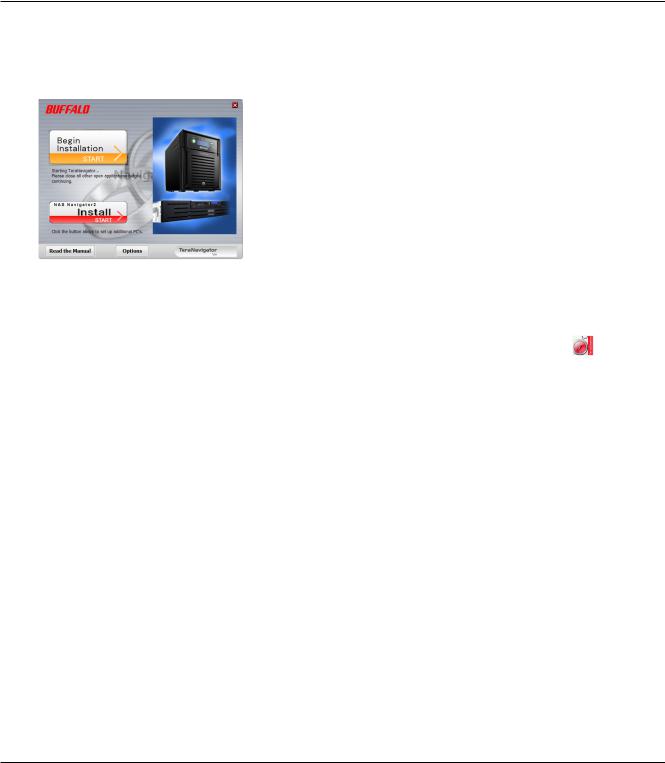
Chapter 1
Diagrams and Layout
TeraNavigator Setup
To configure your TeraStation, follow the procedure described below.
1 Insert the TeraNavigator CD into your computer. TeraNavigator will launch. Click [Begin Installation]. The wizard will guide you through installation.
Follow the steps on the screen to connect the TeraStation's Ethernet and power cables and turn it on.
Notes:
• If TeraNavigator does not open automatically, navigate to the TeraNavigator CD and double-click the icon [TSNavi.exe].
•Use LAN port 1 for initial setup. After setup, you may connect a second cable to LAN port 2. If used, configure the IP address of LAN port 2 at [Network] - [Setting] - [IP Address Settings] in the Web Admin interface or NAS Navigator2.
•If you are using Windows 7 or Vista, the autoplay screen may appear. Click [Run TSNavi.exe].
•If “Do you want to allow the following program to make changes to this computer ?” is displayed in Windows 7, click [Yes].
•If “A program needs your permission to continue” is displayed in Windows Vista, click [Continue].
•For Mac OS, open the CD and double-click on the [TeraNavigator] icon.
•Disable your anti-virus software and firewall before continuing. You may not be able to install the software if antivirus software or a software firewall are enabled. After you’ve finished setup, re-enable your firewall and antivirus software.
3
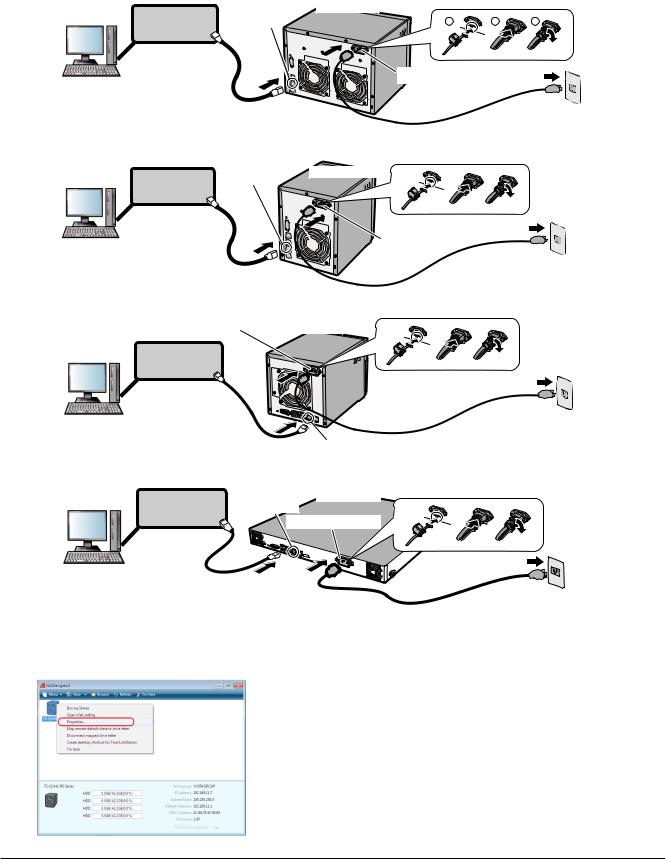
TS-8VHL, TS-6VHL |
|
|
|
TeraStation |
|
|
|
Network |
LAN port 1 |
|
|
||
|
1 |
2 |
3 |
|||
|
(Hub or Router) |
|
|
|
|
|
|
|
|
|
Power connector |
|
|
|
Ethernet cable |
|
Power cable |
Power outlet |
||
|
|
|
|
|
||
|
|
|
|
|
|
|
TS-QVHL |
|
|
|
|
|
|
|
Network |
LAN port 1 |
TeraStation |
|
|
|
|
|
|
|
|
|
|
|
(Hub or Router) |
|
|
|
|
|
|
|
|
|
Power connector |
|
|
|
Ethernet cable |
|
Power cable |
Power outlet |
||
|
|
|
||||
|
|
|
|
|
||
TS-WVHL |
Power connector |
TeraStation |
|
|
||
|
|
|
||||
|
Network |
|
|
|
|
|
|
(Hub or Router) |
|
|
|
|
|
|
Ethernet cable |
Power cable |
Power outlet |
|||
|
|
|||||
|
|
|
|
LAN port 1 |
|
|
TS-RVHL |
Network |
|
LAN port 1 |
TeraStation |
|
|
|
(Hub or Router) |
|
Power connector |
|
|
|
|
|
|
|
|
||
|
Ethernet cable |
|
|
|
|
|
|
|
|
|
|
Power cable |
Power outlet |
2
3
Click [Complete]. NAS Navigator2 will start automatically.
Right-click on your TeraStation’s icon, then choose [Properties] - [IP
Settings].
Note:
For Mac OS, hold the Control key, click on the TeraStation icon, then click [Configure] - [IP Address].
4
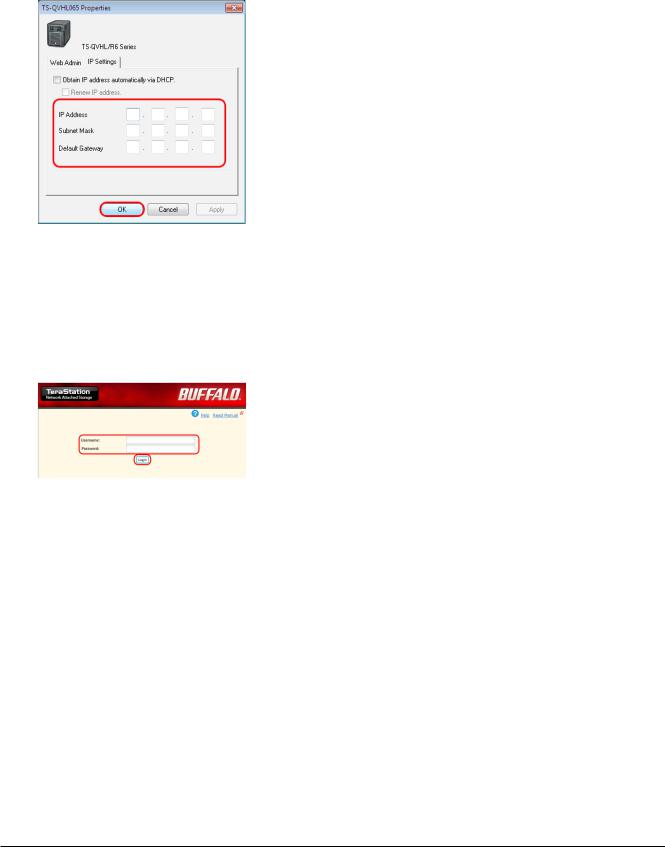
4
Continue to set the TeraStation’s clock.
1 Enter the desired settings.
Note:
If you don’t know how to configure these settings, click [Obtain IP address automatically via DHCP] to check the box. For Mac OS, click [Use DHCP].
2 Click [OK].
Note:
If you are prompted to enter the administrator’s password, enter the TeraStation’s password (it is set to “password” by factory default).
5 Right-click on the TeraStation icon in NAS Navigator2 and choose [Open Web setting].
Notes:
•For Mac OS, hold the Control key, click the TeraStation icon, and click [Open Web setting].
•The Web Admin interface requires Firefox 1.5 or later, Internet Explore 6.0 Service Pack 2 or later, or Safari 3 or later.
6
7
Enter your username and password, then click [Login].
Note: The default settings are:
Username: admin
Password: password
Note:
• The default language for the Web Admin interface is English. To change the display language, click [System] - [Settings] - [Language] - [Modify Settings], select [Display Language], and click [Save].
In the Web Admin interface, navigate to [System] - [Settings] - [Date and Time], then click [Modify Settings].
5
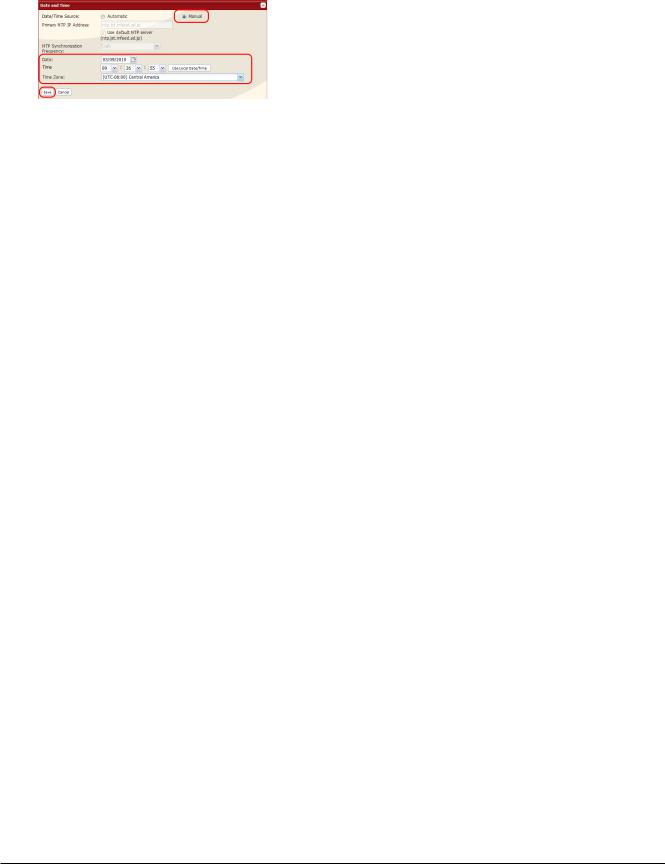
8 |
1 |
To manually configure the date and time, select [Manual] and |
|
|
adjust [Date], [Time], and [Time Zone]. |
|
Note: |
|
|
Click [Use Local Date/Time] to use your computer's time (or Time |
|
|
Zone) for the TeraStation's time. |
|
|
2 |
Click [Save]. |
Notes:
•By default, the TeraStation will attempt to use an NTP server to set the time.
•NTP may not be usable in some network environments.
•Please read the terms of use for Internet Multifeed Co. at www.jst.mfeed.ad.jp. Internet Multifeed Co. is the group that manages this NTP Server. Internet Multifeed Co. is not responsible for any loss or damages caused by this service.
•Buffalo Technology is not responsible for any loss or damage caused by using of this service, stopping the service, or missing service.
•If your TeraStation fails to automatically obtain the time from an NTP Server, verify the TeraStation’s DNS server address settings. You must set a primary DNS server address to specify an NTP server by host name. Otherwise you will have to specify the DNS server by IP address. You can change the DNS server settings at [Network] - [Settings] - [IP Address Settings] in the Web Admin interface.
9 The following settings changes are recommended.
Change your administration password
We recommend that you change the default password to a secure password.
1In the Web Admin interface, navigate to [Users/Groups] - [Local Users] .
2Select [admin] from the user list and click [Edit User].
3-1 Enter a new password (twice). -2 Click [Save].
Your administrator password is now changed.
Configure RAID Scanning
RAID Scanning checks your RAID arrays for problems and automatically fixes any errors it can. To configure:
1In the Web Admin interface, navigate to [System] - [Storage] - [RAID Scanning] - [Modify Settings].
2Click [Enable] for [RAID Scanning].
3Select the schedule to perform RAID Scanning.
Note: With [Immediate] checked, RAID Scanning will run immediately. 4 Click [Save].
You have completed the settings for RAID Scanning.
6
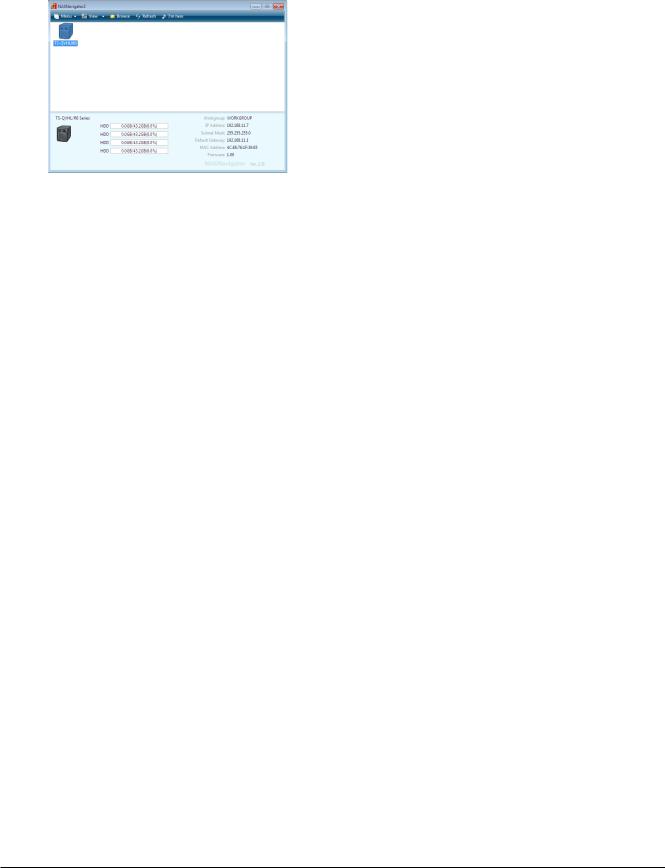
10
Double-click on your TeraStation’s icon.
Note:
This example show a TS-QVHL TeraStation model. Your screen may be slightly different.
11 The TeraStation’s shared folders are displayed.
Note: In OS X, your TeraStation is mounted as a drive icon on the desktop and displayed in the sidebar of the Finder.
Setup is now complete. You can now use the TeraStation’s shared folders to save files just like any other folders.
Note:
•Keep the TeraStation updated with the latest firmware. You can download the latest firmware from www.buffalotech.com. The currently installed firmware version is displayed on the main screen of NAS Navigator2.
7
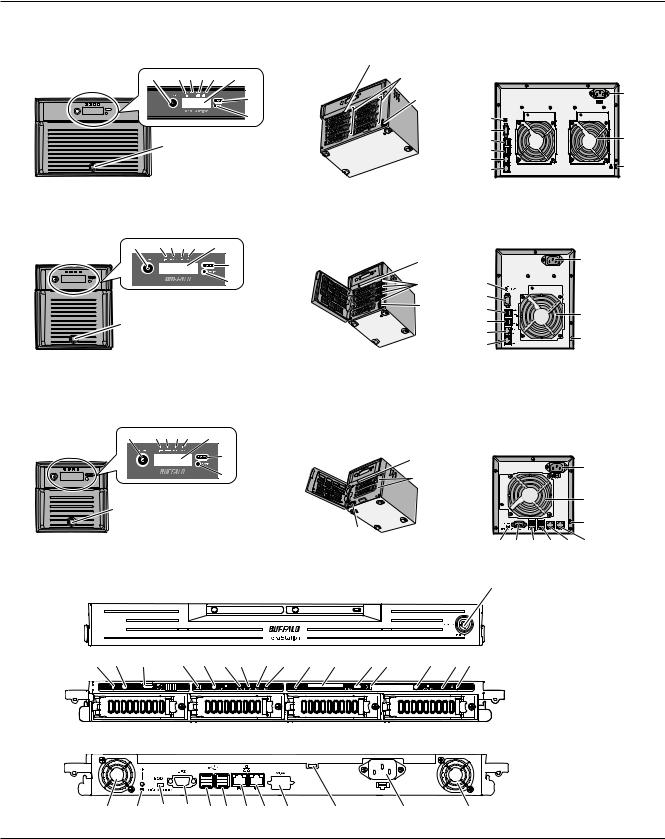
Diagrams and Layout
TS-8VHL, TS-6VHL
Front View
Rear View
±°
± |
² ³ ´ µ ¶ |
±± |
|
|
· |
±² |
±¹ |
|
||
¸ |
±³ |
|
|
|
|
|
±´ |
²° |
¹ |
±µ |
|
±¶ |
|
|
|
|
|
|
±· |
²± |
|
±¸ |
|
|
|
TS-QVHL |
|
|
with cover removed |
|
|
|
|
|
|
|
|
Front View |
|
|
|
Rear View |
|
± |
² ³ ´ µ |
¶ |
|
|
|
|
|
· |
±° |
|
±¹ |
|
|
¸ |
±± |
±³ |
|
|
|
|
±² |
±´ |
|
|
|
|
±µ |
²° |
|
¹ |
|
|
|
±¶ |
|
|
|
|
|
||
|
|
|
|
±· |
²± |
|
|
|
|
±¸ |
|
|
|
|
|
|
|
TS-WVHL |
|
|
|
|
|
Front View |
|
|
|
Rear View |
|
± |
² ³ ´ µ |
¶ |
|
|
|
|
|
· |
±° |
|
|
|
|
|
|
±¹ |
|
|
|
¸ |
±± |
|
|
|
|
|
|
||
¹ |
|
|
|
|
²° |
|
|
|
|
|
|
|
|
|
±² |
|
²± |
|
|
|
|
|
|
|
|
|
|
±³ ±´ ±µ ±¶ ±·±¸ |
|
TS-RVHL |
|
|
|
9 |
|
Front View |
|
|
|
|
|
|
|
|
|
|
|
with cover attached
11 |
12 |
16 |
11 |
22 |
2 |
3 |
4 |
5 |
1 |
6 |
7 11 |
8 |
1011 |
|
||||||||||||
|
|
|
|
|
|
|
|
|
|
|
|
|
|
|
|
|
|
|
|
|
|
|
|
|
|
|
|
|
|
|
|
|
|
|
|
|
|
|
|
|
|
|
|
|
|
|
|
|
|
|
|
|
|
with cover removed
Rear View
20 |
22 |
13 |
14 15 16 1718 |
23 |
21 |
19 |
20 |
8

1 Power Button
Power on: Press the power button to turn on.
Power off: Press the power button twice in 3 seconds.
Note: To power on, connect the power cable and wait for 10 seconds. Then press the power button.
2 Info LED
If there is a message about the current status, the amber info LED is illuminated. Check the LCD panel for current status.
3 Error LED
The red error LED is illuminated when an error occurs. Check the LCD panel for more information.
4 LAN1 LED
When LAN port 1 is connected to a network, it is illuminated in green. The light next to LAN port 1 will be illuminated as well.
5 LAN2 LED
When LAN port 2 is connected to a network, it is illuminated in green. The light next to LAN port 2 will be illuminated as well.
6 LCD Panel
Displays the status of the TeraStation.
7 Display Button
Switches between the different display modes.
8 Function Button
Use this button to perform the following operations:
•DirectCopy
•Removal of USB devices
•Rebuild RAID array after replacing hard drives
•Failover (Backup TeraStation)
9 Drive Lock
Open the front panel with the key to replace hard drives or press the reset button.
10 Reset Button
To shut down and reboot the TeraStation, hold down this button.
11 Status LEDs
LEDs 1 through 8 will glow green when the corresponding hard drives are accessed. If a drive fails, the corresponding LED will glow or flash red (or just flash amber).
12 Factory Use Only
13 Boot Mode Switch
This is a switch used for the TS-6VHL/E, TS-8VHL/E, TSQVHL/E, TS-WVHL/E, and TS-RVHL/E TeraStation models. Normally, use this switch at the default setting of [HDD]. Do not change the switch to the [USB] position.
14 UPS Port
Connect a UPS (Uninterruptible Power Supply).
15 USB 3.0 Port
Compatible Buffalo USB 3.0 hard drives can be connected. USB hubs are not supported.
Note: TS-8VHL TeraStation models do not have this port.
16 USB 2.0 Port
Compatible Buffalo USB hard drives, USB flash drives, digital cameras, and USB UPS connection can be connected. USB hubs are not supported.
17 LAN Port 1
Connect to a router, hub, or switch on your Ethernet network.
18 LAN Port 2
Use this second Ethernet port for redundancy or backup. For backup, a second TeraStation may be connected directly.
19 Power Connector
Use the included power cable to connect to an UPS, surge protector, or outlet.
20 Fan
Do not block the fan while the unit is running.
21 Anti-Theft Security Slot
You can connect an off-the-shelf wire lock to this slot.
22 UID Button
Press the UID button on the front or the back of the unit to cycle the blue LED between on and off.
23 Factory Use Only
Only TS-RVHL TeraStation models have this port.
9
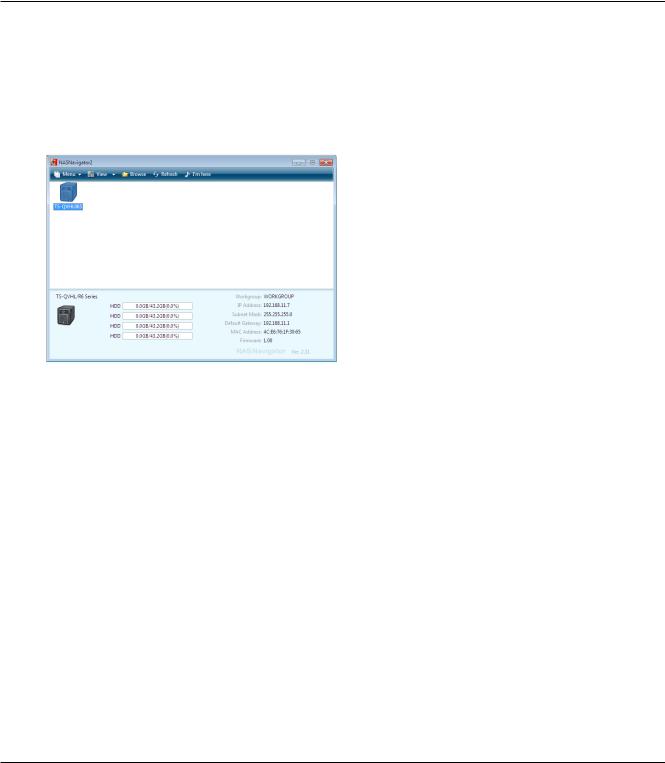
Chapter 2
Using your TeraStation
Opening a Shared Folder
1 |
Launch NAS Navigator2. |
|
Notes: |
2
3
•For Windows, double-click the [Buffalo NAS Navigator2] icon on your desktop.
•For a Mac, double-click on the [NAS Navigator2] icon in the Dock.
Double-click on the TeraStation icon.
The TeraStation’s Shared folders are displayed.
Note:
With a Mac, the TeraStation is mounted as a drive icon on the desktop, and displayed in the sidebar of the [Finder].
You can now use the TeraStation's shared folders to save files just like other hard drives.
10
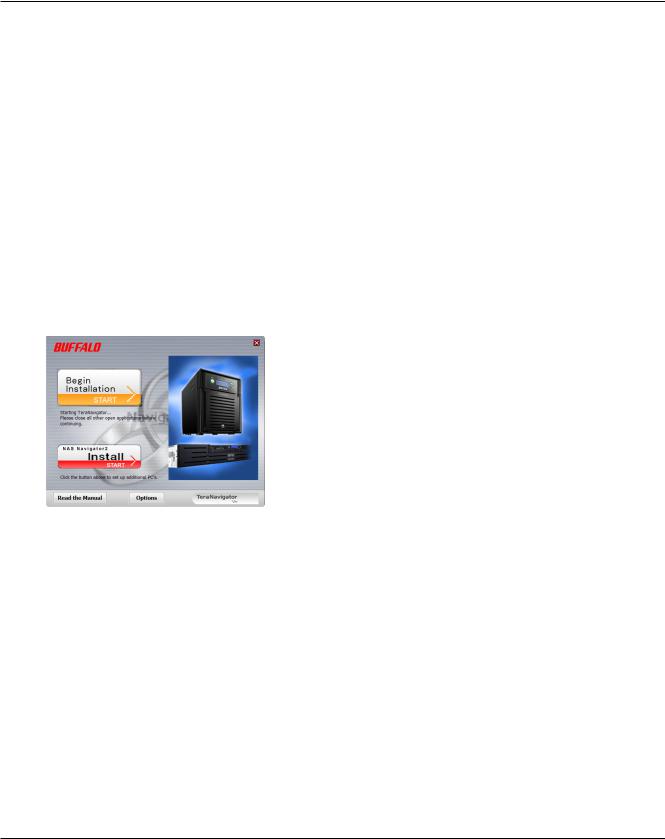
Opening a Shared Folder from a Second PC
Once you’ve connected the first computer to the TeraStation, you don’t have to run the setup program again to connect additional computers. Just install NAS Navigator2 on each additional computer and use it to open the TeraStation’s shared folder as necessary.
1 Insert the TeraNavigator CD into your computer. TeraNavigator will launch.
Notes:
• For Windows 7/Vista, click [Run TSNavi.exe] when the auto-play screen is displayed.
• If [A program needs your permission to continue] is displayed, click [Continue].
• For Mac OS, double-click on the [TeraNavigator] icon in the utility CD.
2 |
Click [Install NAS Navigator]. |
Note:
If this screen doesn’t open, open the CD and double-click on the  icon (TSNavi.exe).
icon (TSNavi.exe).
3
4
Step through the wizard to install NAS Navigator2.
After NAS Navigator2 is installed, click the  in the right top right corner of the window to close the installer. Then, use NAS Navigator2 to open the TeraStation’s shared folder.
in the right top right corner of the window to close the installer. Then, use NAS Navigator2 to open the TeraStation’s shared folder.
11
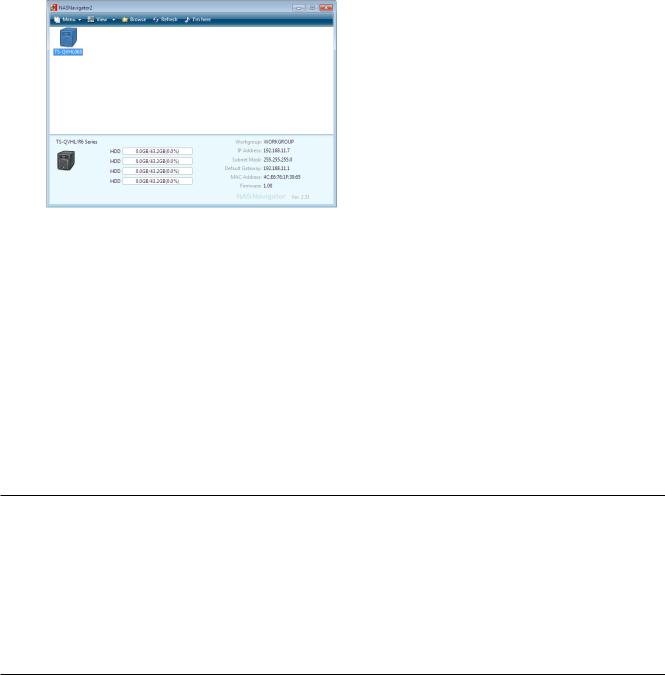
5 |
Launch NAS Navigator2. |
|
Note: |
6
7
•For Windows computers, double-click the [Buffalo NAS Navigator2] icon on the Desktop.
•For a Mac, double-click the [NAS Navigator2] icon in the Dock.
Double-click on the TeraStation icon.
The TeraStation’s Shared folders are displayed.
Note:
With a Mac, the TeraStation is mounted as a drive icon on the desktop, and displayed in the sidebar of the [Finder].
You can now use the TeraStation’s shared folders to save files just like other hard drives.
Adding Additional TeraStations
Run the TeraNavigator installation program from the CD for each TeraStation that you add to the network. You cannot set up multiple TeraStations at the same time.
12
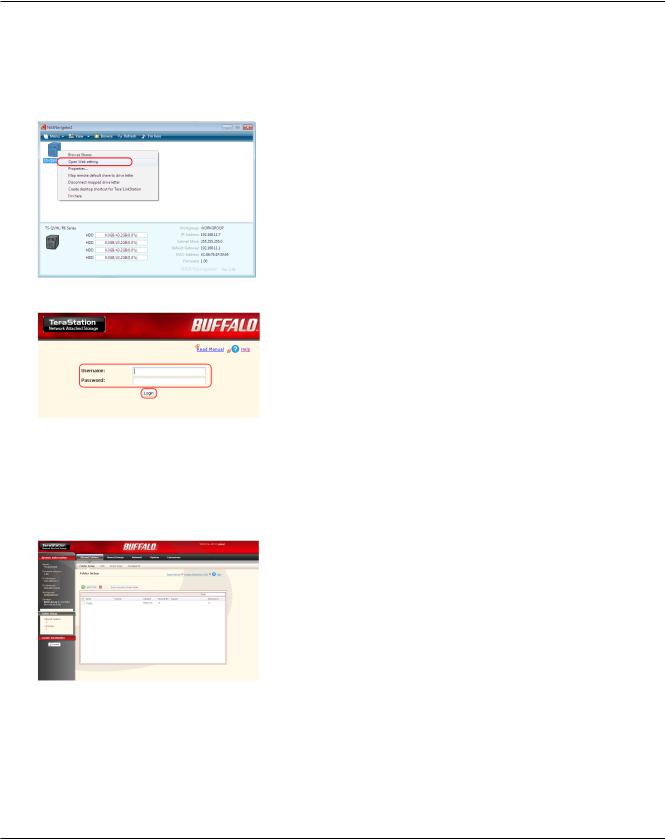
Opening the Web Admin interface
To configure your TeraStation, use the Web Admin interface from a browser on a computer connected to the same network.
1 Launch NAS Navigator2. For Windows, click on the [BUFFALO NAS Navigator2] icon on your desktop. For Mac OS X, double-click on the [NAS Navigator2] icon in the Dock.
2
3
Note:
Right-click on the TeraStation icon (on Mac OS X, click the icon while holding down the control key) and select [Open Web setting] from the menu.
Notes:
•If multiple TeraStations and TeraStations are connected to the network, multiple icons will be displayed. Click on the correct TeraStation.
•Record the TeraStation’s IP address from the bottom right of the NAS Navigator2 window.
1Enter your username and password, and click [Login]. Initially, use the default username and password: Username: admin
Password: password
2After you log in, change the password for security.
• To login as a guest, type “guest” for the Username, leave the password blank, and click [OK]. Guests can check the TeraStation’s name, IP address, workgroup, and disk status. Regular users can change their login passwords as well as check the TeraStation name, IP Address, workgroup, and disk status. Administrator user, “admin” by default, can configure all options.
This is the Web Admin interface. This page displays the 4 TeraStation’s current status, including name, IP address,
workgroup, and hard disk settings.
Notes:
•The Web Admin interface supports Firefox 1.5 or later, Internet Explorer 6.0 with SP2 or later, and Safari 3 or later. It may not display properly in other browsers.
•The Web Admin interface may not display correctly in Internet Explorer due to your browser security settings. If this happens, navigate to [Tools] - [Internet Options] - [Security] on Internet Explorer, and set the Security Settings to [Local intranet].
13
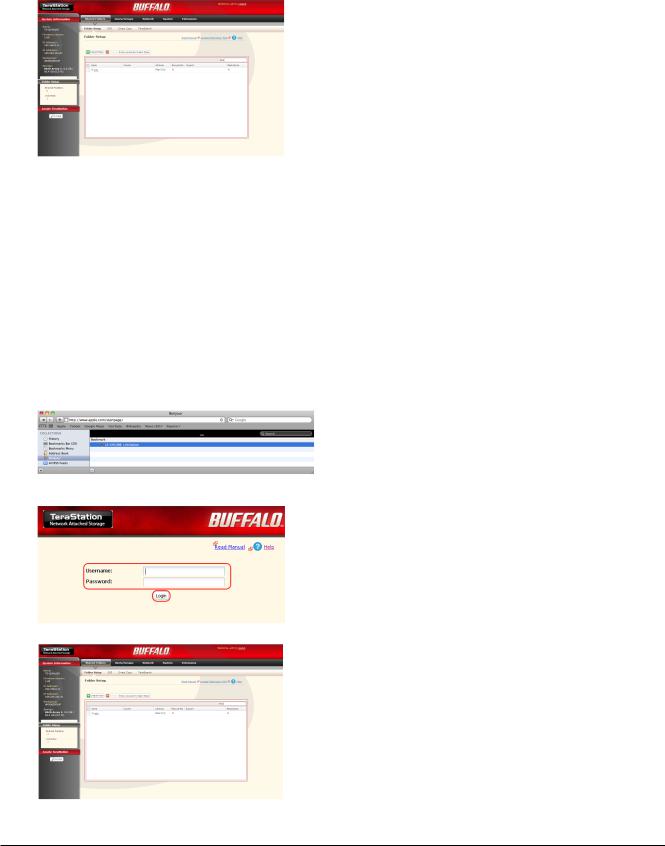
The Web Admin interface is organized by tabs across the top. The following tabs are available.
•[Shared Folders]
Add or delete Shared Folders; configure Access Restrictions, DirectCopy, DFS and TeraSearch.
•[Users/Groups]
Add, delete, and configure Users and Groups.
•[Network]
Configure Network, Workgroup, and NFS settings.
•[System]
Configure Name, Date and Time, RAID setup, RAID Scanning, Check Disk/Format Disk, Backup, Replication, Email Notification, Sleep Timer, UPS Settings, Restore/Erase.
•[Extensions]
Configure Web Access, Print Server, and Time Machine.
Notes:
• You may also open the Web Admin interface by typing the IP address that you wrote down in step 2 into the address field of your browser. Press the <Enter> key and bookmark this page in your browser so that you can return to it easily.
•With Mac OS X 10.4 or later, you can open the Web Admin interface from within Safari with Bonjour.
1
2
3
4
Launch Safari.
Select [View] - [Show Bookmarks Bar] from Safari’s menu.
Select [Bonjour] from the left-side menu, then click on your
TeraStation in the bookmark list.
1Enter your username and password.
2Click [Login].
Note: To log in as a guest, type “guest” as the username and leave the password blank.
5
The Web Admin interface opens.
The TeraStation’s name, IP address and disk information are displayed on the left.
14

Chapter 3
Configuring Access Restrictions
TeraStation allows you to set permissions for users or groups to access specific shared folders. Four types of Access Restrictions are available:
•Access Restrictions for Users and/or Groups on the TeraStation
Follow the procedure on page 23 to configure.
•Access Restrictions on NT Domain
Follow the procedure on page 25 to configure.
• Access Restrictions on Active Directory
Follow the procedure on page 27 to configure.
Notes:
•This chapter describes the procedure to use Active Directory with Windows 2000 Server, Server 2003, and Server 2008.
•Depending on the security settings, the TeraStation may not be able to join, or may be able to join but may not be authenticated by a domain. In such a case, it is recommended to restrict access by delegating authority.
•Restrict access by delegating authority
Follow the procedure on page 29 to configure.
Notes:
• Access restrictions on the TeraStation are configured for shared folders in the root folder. Subfolders inherit their permissions from their parent folder and may not be configured separately.
•Permissions on the TeraStation are configured from within the Web Admin interface. Changing TeraStation permissions on the fly from within Windows or OS X is not supported.
15
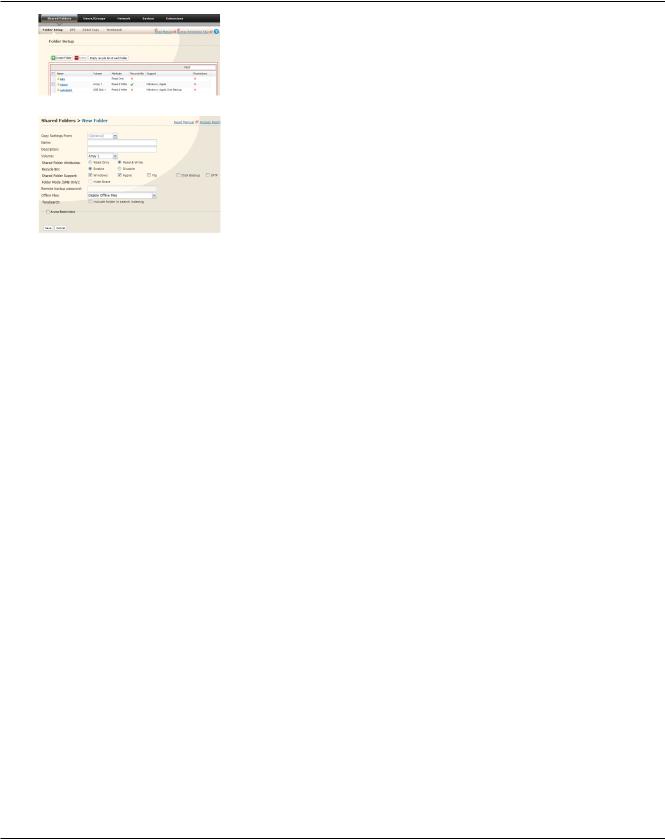
Adding a Shared Folder
1 |
1 |
In the Web Admin interface, click [Shared Folders] - [Folder Setup]. |
|
2 |
Click [Create Folder]. |
2 |
1 |
Configure the desired settings for the new folder. |
|
2 |
Click [Save]. |
Notes:
•Shared folder names can contain up to 27 bytes (UTF-8). Alphanumeric characters, multi-byte characters, -(hyphen), and _(underscore) may be used. Do not use a symbol as the first character.
•Shared folder descriptions can contain up to 75 bytes (UTF-8). Alphanumeric characters, multi-byte characters, -(hyphen), _(underscore), and spaces may be used. Do not use a symbol as the first character.
• You may create up to 400 shared folders on the TeraStation.
You have created a new shared folder.
16
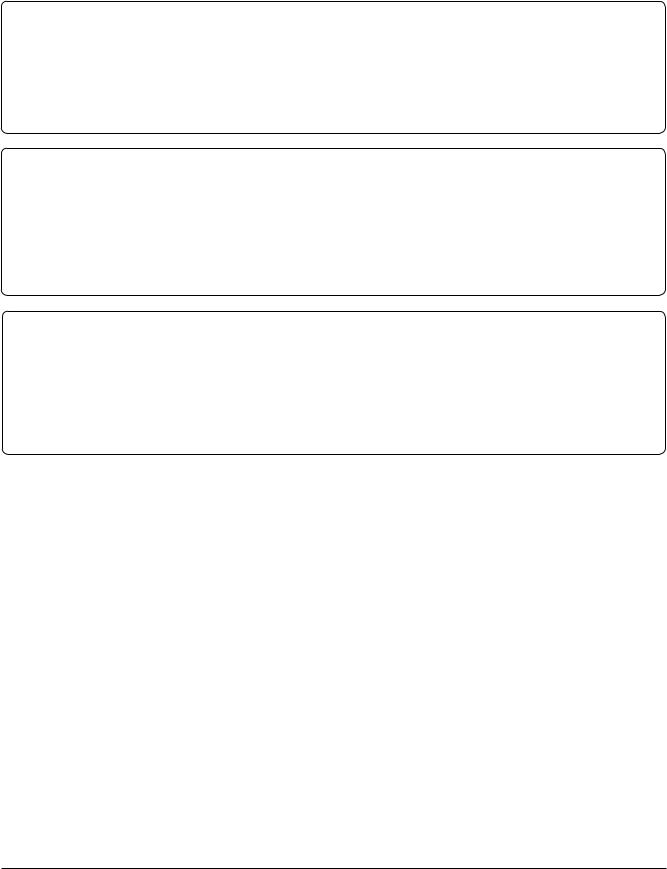
[Recycle Bin]
Each shared folder on the TeraStation that is connected by SMB may have the recycle bin enabled or disabled from within the Web Admin interface. If enabled, deleted data from a shared folder will be temporarily moved to a [Trashbox] subfolder. To recover deleted data, open the [Trashbox] folder and move files.
Notes: To delete all files in the Recycle Bin, click [Shared Folders] - [Folder Setup] - [Empty recycle bin of each folder] on the Web Admin interface.
[Read Only] Shares
A folder may be configured as read-only by selecting [Read Only] from [Shared Folder Attributes].
Notes: The default setting is [Read & Write].
A shared folder whose attribute is set to [Read Only] is read-only for all users, even if they are assigned write permissions on the share.
When a shared folder is configured to [Read Only], the message “(Read Only)” is added to the description of that share folder.
[Hide Share]
In theWeb Admin interface, click [Shared Folders] and select [Hide Share] on [Folder Mode (SMB Only) ]. Click [Save].
OnlySMBsharesmaybehidden. Ifotherprotocolsarecheckedfortheshare,suchas[Apple],[Ftp],or[SFTP],youcannotselect[Hide
Share].
To open a hidden share, click [Start] - [Run] and enter \\TeraStation Name\Shared Folder name$\. Example: If yourTeraStation is
named “TS-XL001” with the default share“share” hidden, enter \\TS-XL001\share$\.
17

Technical Restrictions
•Windows does not support some characters that OS X and the TeraStation allow. So, if you create a filename on a Mac with any of the following characters, it will not display correctly on a Windows computer. With Mac OS X 10.2 or later, you may have to connect to the TeraStation via AFP in order to display or copy any of the following characters: ? [ ] / ¥ = + < > ; : ” , | *
•Do not use any of the following words as a Username or Group Name: root, bin, daemon, sys, adm, tty, disk, lp, sync, shutdown, halt, operator, nobody, mail, news, uucp, ftp, kmem, utmp, shadow, users, nogroup, all, none, hdusers, admin, guest, man, www, sshd, administrator, ftpuser, apache, mysql.
•Do not use any of the following words as a shared folder name: info, spool, usbdisk1, usbdisk2, usbdisk3, usbdisk4, usbdisk5, lost+found, global, printers, homes, lp, auth, ram, disk1, disk2, disk3, disk4, disk5, disk6, disk7, disk8, array1, array2, array3, array4.
•When using multi-byte characters (such as Japanese), make folder and file names with 80 bytes or less. Total pathlength is limited to 1024 bytes. You may not be able to copy a folder or file whose name is more than 80 bytes characters long, or whose pathname is more than 1024 bytes total.
•You cannot set hidden or read-only attributes to folders or files on a TeraStation from Windows. To set an attribute for a share on the TeraStation, use the Web Admin interface. In [Shared Folders] - [Folder Setup], click the shared folder you want to configure. Select [Read Only] or [Read & Write] from [Shared Folder Attributes], and [Hide Share] from [Folder Mode (SMB Only)].
•If local characters aren’t displayed properly in a Shared Folder or Workgroup name, use alphabetical character.
•If you access a shared folder from a Macintosh computer, information files for Macintosh may be automatically generated. Do not delete these files from a Windows computer. Otherwise, you may no longer access folders from Macintosh.
•A volume name mounted by [Finder] from Mac OS X 10.3.9 may be corrupted when connected via SMB. File names and data should be fine.
•On Mac OS X 10.5 - 10.5.6, you cannot search by Spotlight while connected via AFP. In such a case, use SMB connection or use Mac OS X 10.5.7 or later.
•TeraStation belongs to the default zone specified by an AppleShare Server. You cannot specify a zone.
•Date and Time stamp information stored on a TeraStation’s hard disk or a USB hard disk connected to the TeraStation may be updated by an attached OS, and its accuracy cannot be guaranteed.
•If you display size of hard drives through the Web Admin interface, it will show a larger value than that shown by Windows’ drive properties.
•If you change a TeraStation’s settings or add a USB hard drive while transferring files, the file transfer may be aborted.
•Copying files to TeraStation is protected by the Journaling File System. However, if power is suddenly disconnected in the middle of a file copy, the following events may occur:
-- Data configured (TeraStation, User or Group names) may be lost.
-- The copied file may be incomplete and it may not be deleted. In such a case, restart TeraStation and delete the file, and try copying the file again.
•Although you format TeraStation’s hard disk, [Percent Used] or [Amount Used] in the Web Admin interface will not show 0 (zero). This is because some space is used for the system.
•Set the TeraStation’s username and password the same as the user’s username and password for logging into the Windows network. If they are different, you may not be able to access share folders with access restrictions.
•Click [Shared Folders] - [Folder Setup] - [Empty recycle bin of each folder] in the Web Admin interface to delete all of the contents of the [Recycle Bin] folder in the shared folder.
•Do not set the same network address for LAN port 1 and LAN port 2, or data transmission may be unstable.
18

•If you want to access a different network from the TeraStation, use LAN port 1. LAN port 2 cannot access beyond the local subnet as it doesn’t have a default gateway.
Examples: You cannot use Mail Notification (cannot find the mail server), or you cannot find a TeraStation by IP address to configure as a backup destination.
To resolve, place the TeraStation on the same subnet as the device that you are trying to connect to via LAN port 2.
19
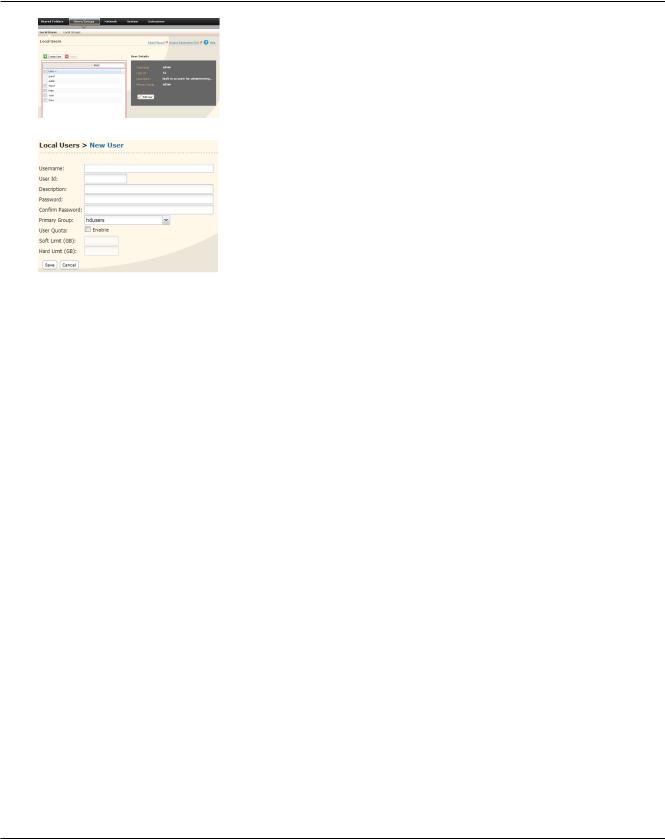
Adding Users
1
2
1Click [Users/Groups] - [Local Users].
2Click [Create User].
1Enter [Username], [Description], and [Password].
2Click [Save].
Notes:
•Usernames can contain up to 20 bytes (UTF-8). Do not use multi-byte characters. Alphanumeric characters, -(hyphen), _(underscore), .(dot), !, #, &, @, $, *, ^, % may be used. Do not use a symbol as the first character.
•User descriptions can contain up to 75 bytes (UTF-8). Alphanumeric characters, multi-byte characters, -(hyphen), _(underscore), and spaces may be used. Do not use a symbol and space as the first character.
•You may register up to 300 local users with the TeraStation.
•Passwords can contain up to 20 bytes (UTF-8). Do not use multi-byte characters. Alphanumeric character and the
following characters may be use: - _ @ ! # $ % & ‘ ( ) * + , . / ; < > = ? [ ] ^ { } | ~ Do not use a symbol except -(hyphen) as the first character.
•Set the TeraStation’s username and password the same as the user’s username and password for logging into the Windows network. If they are different, the user may not be able to access shared folders with access restrictions.
•Repetitive deletions and additions of users may cause the Quota feature to not work properly. Even though the data is copied by the backup function of the TeraStation, the Quota feature may not work properly if a user ID/group ID is duplicated. In such a case, use a user name/group name of an unused user ID or group ID.
•To assign Quotas for users, check [Enable] for User Quota and enter a limit in GB. Refer to “TeraStation Hard Drive Operating Guide“ for details.
•If the user ID is left blank, a user ID will be automatically assigned. When using the Quota feature, use numbers between 1000 and 1999 to set a group ID manually. Make sure that user ID are unique.
20

Importing Users
To import many users at once, enter the following information in the [Input CSV format data] field on [Users/ Groups] - [Local Users] on the Web Admin interface, and click [Import].
Format of the user information: Username (required), Password (required), and Description (optional)
Example)
username1, password1, description1 username2, password2, description2 username3, password3, description3
…
…
…
Notes: • It may take about 1 hour depending on the number of users you import. Please note that you cannot use the Web Admin interface while the system is busy.
•Use commas as separators. Do not use spaces before or after the commas.
•If a line is incorrectly formatted, then the user in that line will not be registered.
•If a username is already registered on the TeraStation, that user will be overwritten.
•Commas should not be used in usernames, passwords, or user descriptions
21
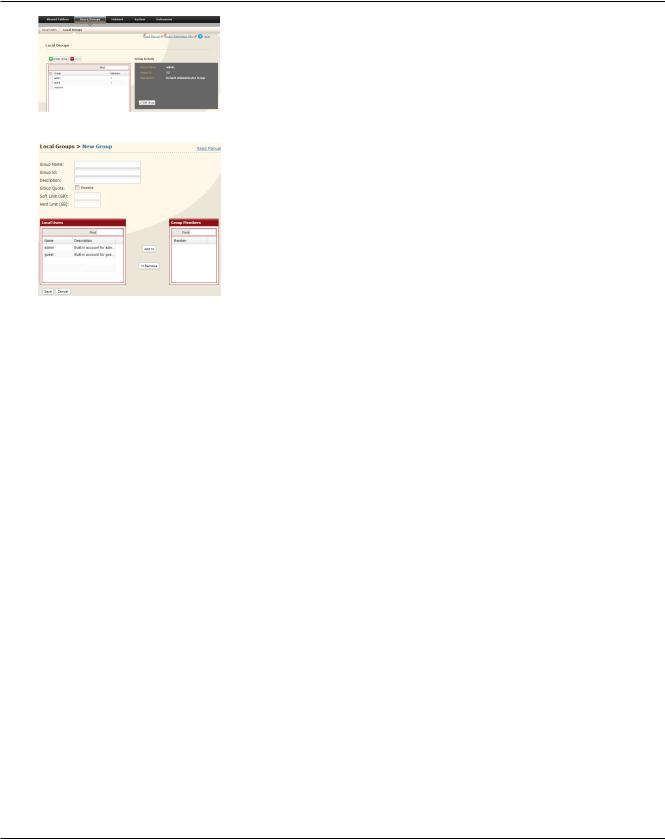
Adding Groups
1
2
1Click [Users/Groups] - [Local Groups] in the Web Admin interface.
2Click [Create Group].
1Enter [Group Name] and [Description].
2Select users who join a group, click [Add].
3Click [Save].
Notes:
•Group names can contain up to 20 bytes (UTF-8). Do not use multi-byte characters. Alphanumeric characters, -(hyphen), _(underscore), and .(dot) may be used. Do not use a symbol as the first character.
•Group descriptions can contain up to 75 bytes (UTF-8). Alphanumeric characters, multi-byte characters, -(hyphen), _(underscore), and spaces may be used. Do not use space as the first character.
•You may register up to 300 groups with the TeraStation.
•Repetitive deletions and additions of groups may cause the quota feature to not work properly. Even though the data is copied by the backup function of the TeraStation, the Quota feature may not work properly if a user ID/group ID is duplicated. In such a case, use a user name/group name of an unused user ID or group ID.
•If the Group ID is left blank, a Group ID will be automatically assigned. When using the Quota feature, use numbers between 1000 and 1999 to set a group ID manually. Make sure that a user ID does not duplicate to other users.
•To set a Quota for a group, check [Enable] for Group Quota, and enter the maximum disk space allotted in GB. Refer to “TeraStation Hard Drive Operating Guide“ for details.
22
